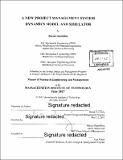A new project management system dynamics model and simulator
Author(s)
Gozluklu, Burak
DownloadFull printable version (13.21Mb)
Other Contributors
System Design and Management Program.
Advisor
Nelson Repenning.
Terms of use
Metadata
Show full item recordAbstract
Simulators generated from project management system dynamics models are exercised for training the future project managers. In today's' high dynamic, vibrant and complex markets, the models should incorporate more business dynamics and also provide more tools to the players who can flexibly steer in the project games. Along with that objective, this study brings new dynamics and modeling approach to the original multi-phase project system dynamics model of Ford and Sterman, 1998. The new dynamics include the development of new features in the market growing the customer expectation, reflection of customer expectation to project economics, supersede of project concurrencies by rushing the tasks, allowing the defects delivered to customers to be compensated by lifetime repair cost and free positioning of the phase schedules while maintaining concurrencies. A new formulation for completion putthrough, option to include final downstream defect correction and elaborate project econometrics are also included. The model is built in modules that can be utilized to increase the number of phases and/or explain the model to the trainees more easily. The project model employs two options; a zero-defect policy and allowed defect policy where the latter is newly introduced by the repair cost. The system dynamics model is tested by proposed extreme project manager traits which are implemented as table function to use one or more modules to pursue an ultimate objective within a certain logic. A construction project principally mimicking the cases provided by Parvan et al. 2015 is simulated with the manager traits. The results initiate interesting tradeoffs such as the influence of project delivery time versus repair cost, accepting new tasks versus creating more defects or rescheduling the project or positioning the workforce before the ramping up of testing and defective task correction activities. The model necessitates a deeper understanding and analyses of long-term phenomenon such as the lifetime repair cost, the financial consequences of defects and lifetime earnings of products as well as the continuous feature development in the market and its economic value. It is found that the current model proposes an enhanced tool for the training of future project managers. Keywords: System dynamics, project management, simulation, defect policy, numerical modeling.
Description
Thesis: S.M. in Engineering and Management, Massachusetts Institute of Technology, System Design and Management Program, 2017. Cataloged from PDF version of thesis. Includes bibliographical references (pages 56-57).
Date issued
2017Department
Massachusetts Institute of Technology. Engineering and Management Program; System Design and Management Program.; Massachusetts Institute of Technology. Integrated Design and Management ProgramPublisher
Massachusetts Institute of Technology
Keywords
Engineering and Management Program., Integrated Design and Management Program., System Design and Management Program.